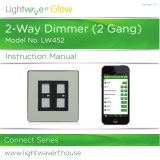
Applicaons
The Smart Relay is a very versale device that can be
used to remotely switch on/o a circuit. Because the
relay includes one latching posion, it can be used to
operate devices that require an on/o control.
Loading
The Smart Relay can be used to switch loads of up to
700W. The switched circuit can be mains powered or
volts free (low voltage). Mains power can also be taken
from the Relay itself to power the circuit (see wiring
instrucons for more informaon).
Locaon
The Smart Relay needs to be housed in a suitable
enclosure to minimise the risk of contact with live
electrical wires and to ensure that the device meets
IEC Class II requirements. The Lightwave LW824
Waterproof housing can be used for this purpose and
will also allow the Relay to be installed outdoors.
Range
Lightwave devices have excellent communicaon range
within a typical home, however, if you encounter any
range issues, try to ensure that large metal objects or
bodies of water (e.g. radiators) are not posioned in
front of the device or in between the device and the
Lightwave Link Plus.
Help video & further guidance
For addional guidance, and to watch a video that will
help guide you through the installaon process, please
visit the support secon on www.lightwaverf.com.
Environmentally friendly disposal
Old electrical appliances must not be disposed of
together with residual waste, but have to be disposed
of separately. The disposal at the communal collecng
point via private persons is for free. The owner of old
appliances is responsible to bring the appliances to these
collecng points or to similar collecon points. With this
lile personal eort, you contribute to recycle valuable
raw materials and the treatment of toxic substances.
Installaon
If you plan to install this product yourself, please follow
the electrical wiring instrucons carefully to ensure the
product is installed safely, if in any doubt please consult a
qualied electrician.
It is important to install this product in accordance with
these instrucons. Failure to do so may risk personal
safety, create a re hazard, violate the law and will also
void your warranty. LightwaveRF Technology Ltd will not
be held responsible for any loss or damage resulng from
not correctly following the instrucon manual.
IMPORTANT: Any electrical installaon must comply with
Building Regulaons, BS 7671 (IET Wiring Regulaons)
or local equivalent.
IMPORTANT: If conducng an insulaon resistance test,
any hard-wired Lightwave devices must be disconnected
from the mains, or damage to the unit may occur.
IMPORTANT: High-Power inducve loads can potenally
damage the device and are not recommended.
Preparaon
Suitable electrical screwdrivers
Knowledge of how to safely turn o/on
mains electricity
You will need
Your Link Plus and smartphone
A safe place in which to situate the Relay
RF frequency:
868 MHz
Input rang:
230V~ 50Hz
Device class:
0 (requires housing)
Warranty:
2 year standard warranty
Output rang:
700W
Standby energy use:
Less than 1W
EU Declaraon of Conformity
Product: Smart Relay with Switch Sense Input
Model/Type: LP81
Manufacturer: LightwaveRF
Address: The Assay Oce, 1 Moreton Street,
Birmingham, B1 3AX
This declaraon is issued under the sole responsibility
of LightwaveRF. The object of the declaraon described
above is in conformity with the relevant union
harmonisaon legislaon.
Direcve 2011/65/EU ROHS, Direcve 2014/53/EU:
(The Radio Equipment Direcve)
Conformity is shown by compliance with the applicable
requirements of the following documents:
Reference and date:
EN 60669-1:1999+A1:2002+A2:2008, EN60669-2-
1:2004+A1:2009+A12:210, EN 55015:2013+A1:2015,
EN 61547:2009, EN 61000-3-2:2014, EN 61000-3-
3:2013, EN 62479:2010, EN 301489-3 V2.1.1, EN
300 220-1 V3.1.1 (2017-02), EN 300 220-2 V3.1.1
(2017-02)
Signed for and on behalf of:
Place of Issue: Birmingham
Date of Issue: February 2022
Name: John Shermer
Posion: CTO
1UK
Specicaon
Wiring terminals
Neutral wire
connecon
This wire is usually blue
or black in colour
Line wire connecon
This wire is usually brown
or red in colour
Terminal screws
Flip down cover to expose
terminal screw heads
Main buon
Hold to enter linking
mode. Click to operate
the Relay.
LED indicator light
The colour indicates the current posion of the relay.
Red (or user customisable): circuit not connected.
Blue: circuit connected.
Fuse access
T5AH250V
Mounng bracket











